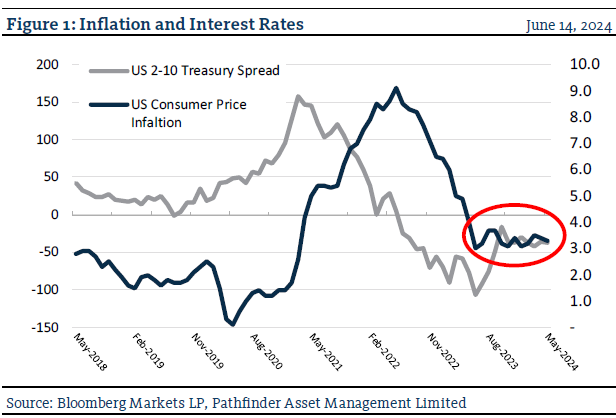Dis...Inflation
It seems like we have been writing a lot about inflation recently. For years, with administered and market interest rates at secular lows, inflation was not on the radar of most investors. Indeed, there were periods of time where inflation had been declared “dead”, while at the same time many countries and regions were struggling with deflation (Europe and Japan are obvious examples). COVID changed all of that. A combination of extreme fiscal and monetary stimulus, along with huge tidal-like adjustments in the global supply chain for essentially all items, resulted in the dramatic increase in inflation in spring of 2021 that we all experienced. The result was administered and short-term interest rates from around the world shot higher, and this led to an inversion in bond yields (please see Figure 1). An inversion is a relatively rare financial phenomenon where short-term rates move higher than long-term. Inversions usually precede a recession and tend to be short lived as central banks quickly drop rates in an attempt to reinvigorate the economy. However, this time the inversion has held, which has led to some confusion among investors and financial pundits alike.
Inflation has been sticky, as you can see with the red circle in Figure 1. However, this week the market was surprised by data that showed that the growth rate of inflation has started to slow (i.e. disinflation). This is a generally positive development, but we point out the following statement which we think we should pay attention to:
“I would want to see a few more months of good inflation data: inflation coming down, the short-run inflation expectations starting to move down… what’s going on in the labor market, to move rates down,” Cleveland Fed President Loretta Mester

“This means that” the data this week was good. Hopefully over the coming months similar data will be released and a trend will emerge. This could then lead to an accommodation in interest rates in attempt to clearly engineer a soft landing. Another indicator to watch (mentioned by President Mester above) is the job market. A combination of lower inflation and weaking employment data would make it easy for the central banks around the world to cut rates, and this would ultimately be good for the economy and the companies that we own in our funds and portfolios.
National Instrument 31-103 requires registered firms to disclose information that a reasonable investor would expect to know, including any material conflicts with the firm or its representatives. Doug Johnson and/or Pathfinder Asset Management Limited are an insider of companies periodically mentioned in this report. Please visit www.paml.ca for full disclosures.
Changes in Leverage. We are increasing the asset ceiling to 2.0 times the market value of equity for Pathfinder International Fund and Pathfinder Conviction Fund to be consistent with Pathfinder Partners’ Fund and Pathfinder Resource Fund.
*All returns are time weighted and net of investment management fees. Returns from the Pathfinder Partners’ Fund and Partners’ Real Return Plus Fund are presented based on the masters series of each fund. The Pathfinder Core: Equity Portfolio and The Pathfinder Core: High Income Portfolio are live accounts. These are actual accounts owned by the Pathfinder Chairman (Equity) and client (High Income) which contain no legacy positions, cash flows or other Pathfinder investment mandates or products. Monthly inception dates for each fund and portfolio are as follows: Pathfinder Core: Equity Portfolio (January 2011), Pathfinder Core: High Income Portfolio (October 2012) Partners’ Fund (April 2011), Partners’ Real Return Plus Fund (April, 2013), and Partners’ Core Plus Fund (November 2014).
Pathfinder Asset Management Limited (PAML) and its affiliates may collectively beneficially own in excess of 10% of one or more classes of the issued and outstanding equity securities mentioned in this newsletter. This publication is intended only to convey information. It is not to be construed as an investment guide or as an offer or solicitation of an offer to buy or sell any of the securities mentioned in it. The author has taken all usual and reasonable precautions to determine that the information contained in this publication has been obtained from sources believed to be reliable and that the procedures used to summarize and analyze such information are based on approved practices and principles in the investment industry. However, the market forces underlying investment value are subject to sudden and dramatic changes and data availability varies from one moment to the next. Consequently, neither the author nor PAML can make any warranty as to the accuracy or completeness of information, analysis or views contained in this publication or their usefulness or suitability in any particular circumstance. You should not undertake any investment or portfolio assessment or other transaction on the basis of this publication, but should first consult your portfolio manager, who can assess all relevant particulars of any proposed investment or transaction. PAML and the author accept no liability of any kind whatsoever or any damages or losses incurred by you as a result of reliance upon or use of this publication.